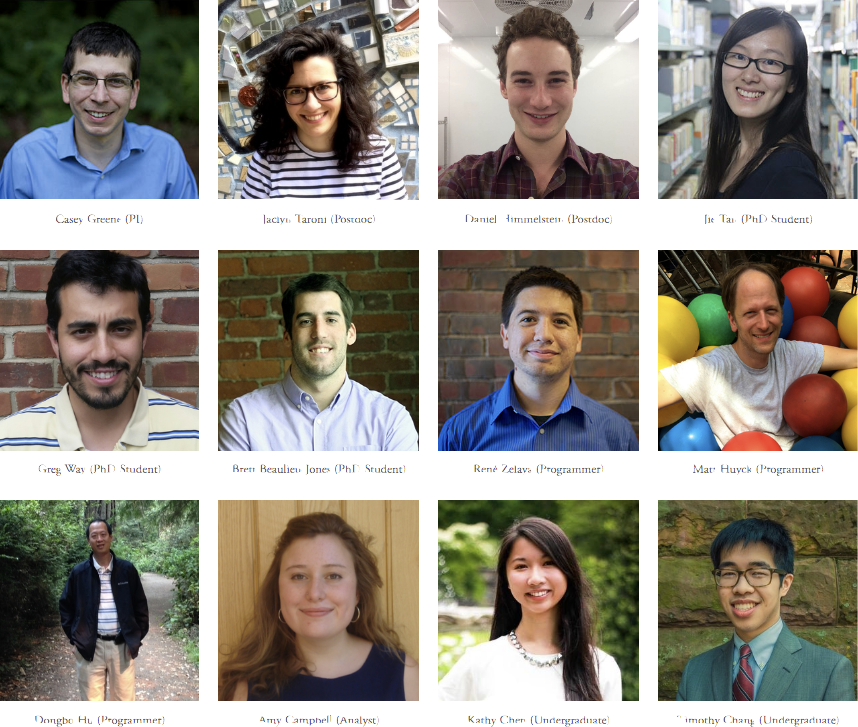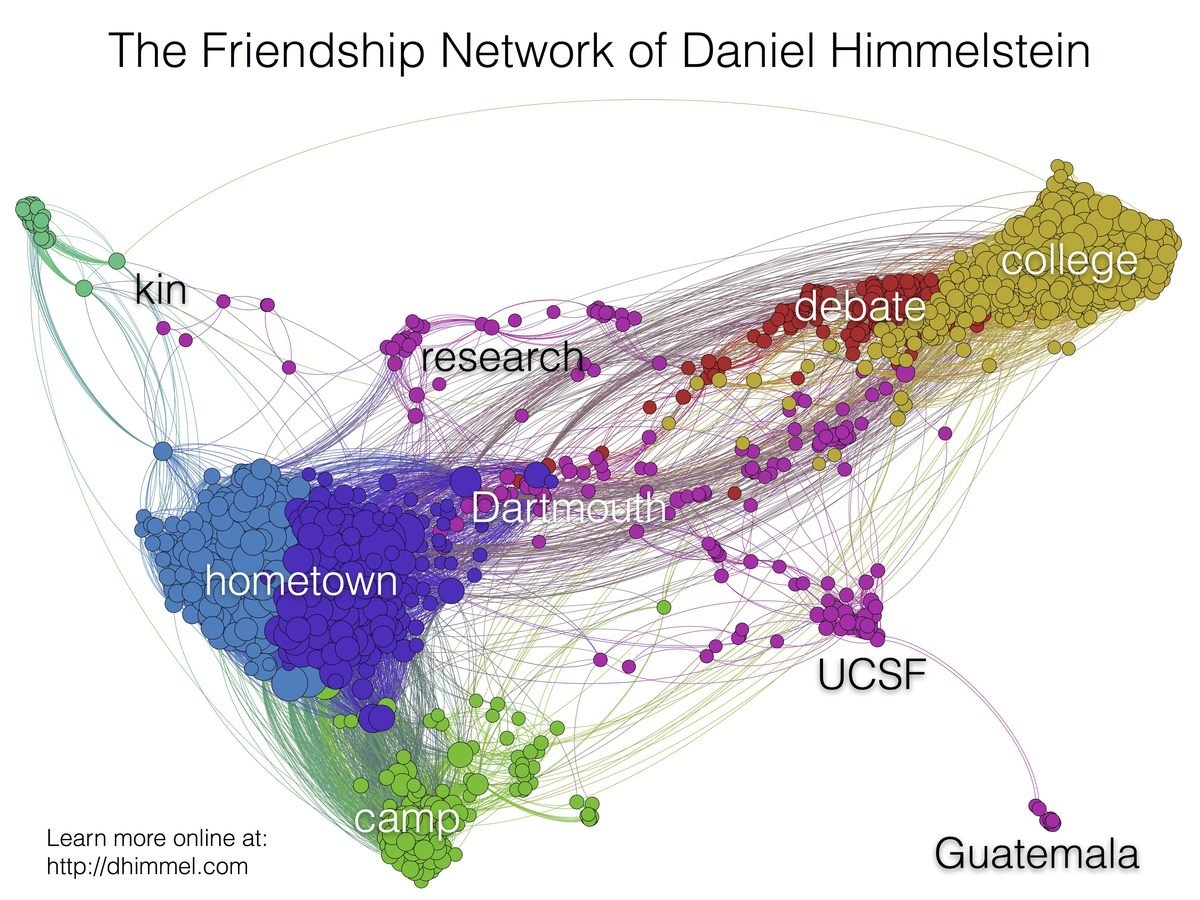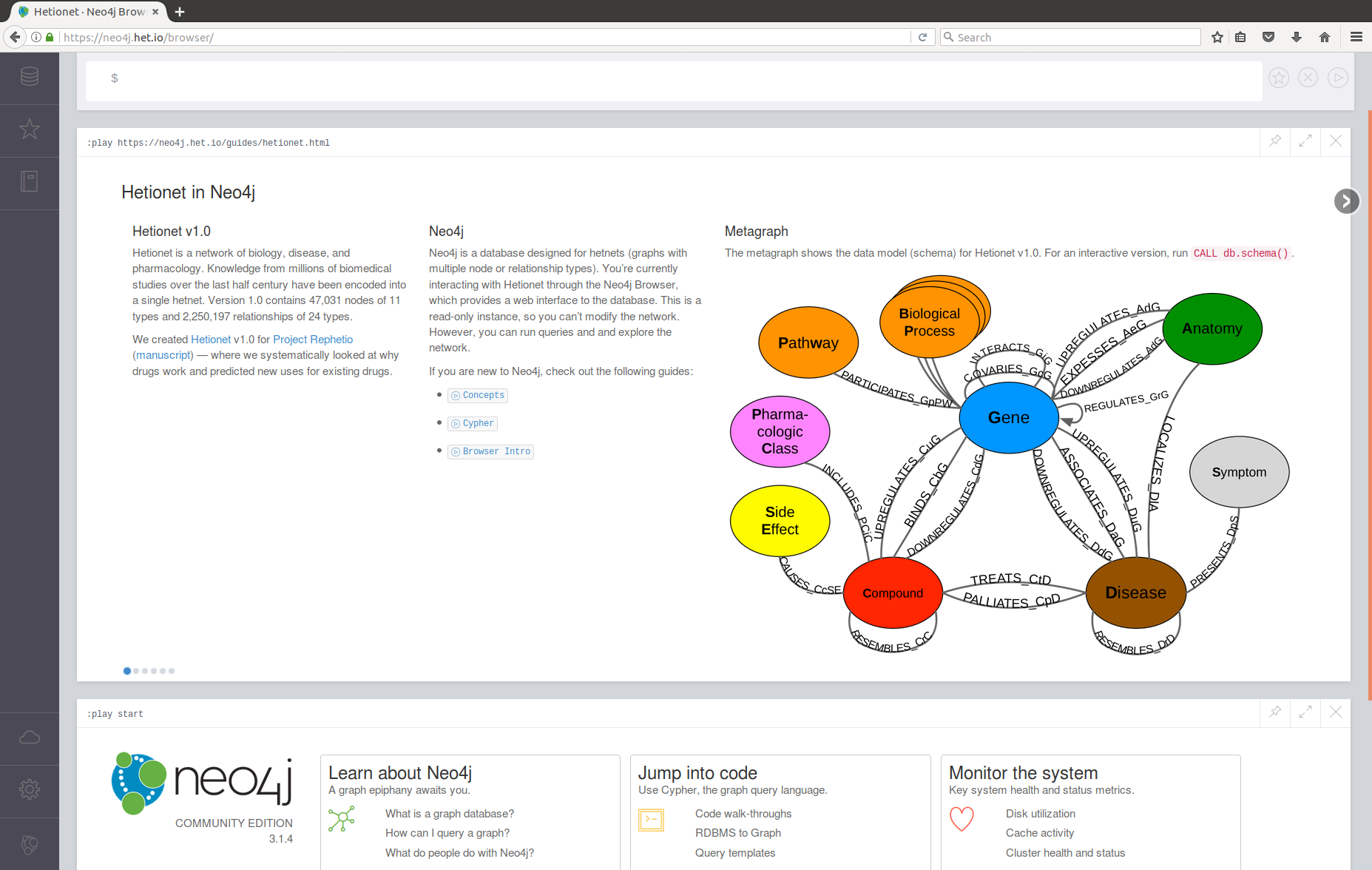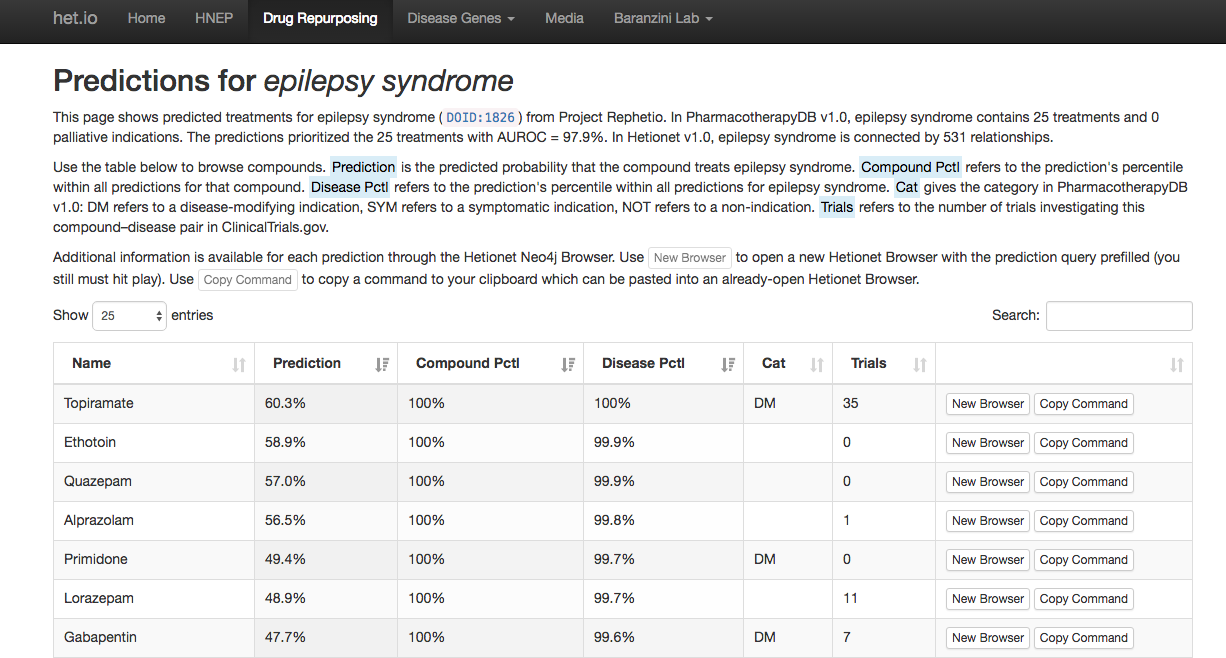Heterogeneous networks to integrate biomedical knowledge and predicting new uses for existing drugs
Oxford University
February 27, 2019
Slides at slides.com/dhimmel/oxford
The hetnet awakens: understanding complex diseases through data integration and open science
Greene Lab
I'm a data scientist
http://www.greenelab.com/
How I became intestested in graphs
http://blog.dhimmel.com/friendship-network/
My Facebook friendship network in 2014
too simple
single node type
single relationship type
networks with multiple node or relationship types
multilayer network, multiplex network, multivariate network, multinetwork, multirelational network, multirelational data, multilayered network, multidimensional network, multislice network, multiplex of interdependent networks, hypernetwork, overlay network, composite network, multilevel network, multiweighted graph, heterogeneous network, multitype network, interconnected networks, interdependent networks, partially interdependent networks, network of networks, coupled networks, interconnecting networks, interacting networks, heterogenous information network
A 2012 Study identified 26 different names for this type of network:
hetnet
How do you teach a computer biology?

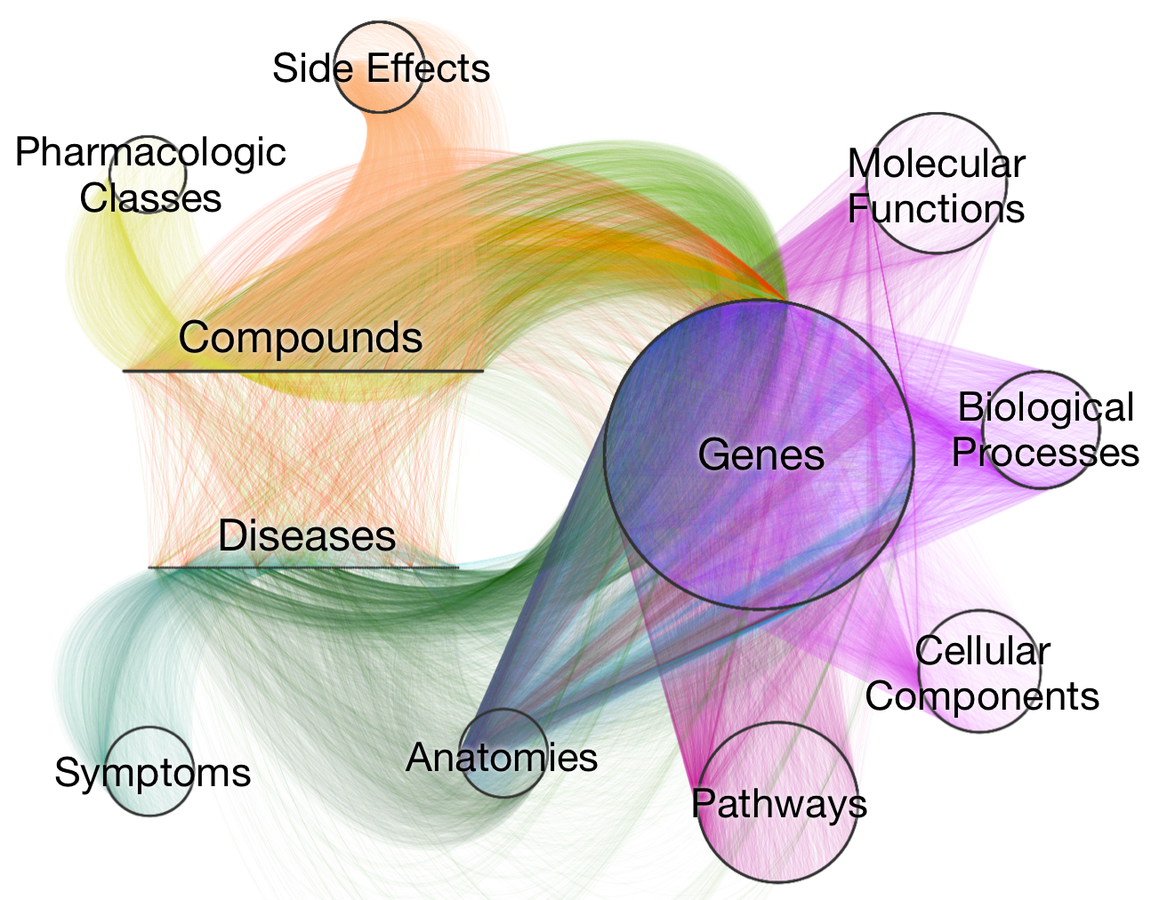
Visualizing Hetionet v1.0
- Hetnet of biology for drug repurposing
- ~50 thousand nodes
11 types (labels)
- ~2.25 million relationships
24 types
- integrates 29 public resources
knowledge from millions of studies
Hetionet v1.0
- Nodes
- standardized vocabularies
- stable, unambiguous identifiers
- Relationships:
- Omics scale required
- Literature mining
- High throughput experimental technologies
- Avoid manual mapping
- Versioned data dependencies
Constructing Hetionet v1.0

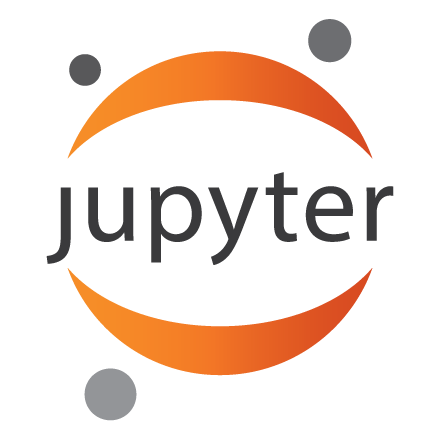
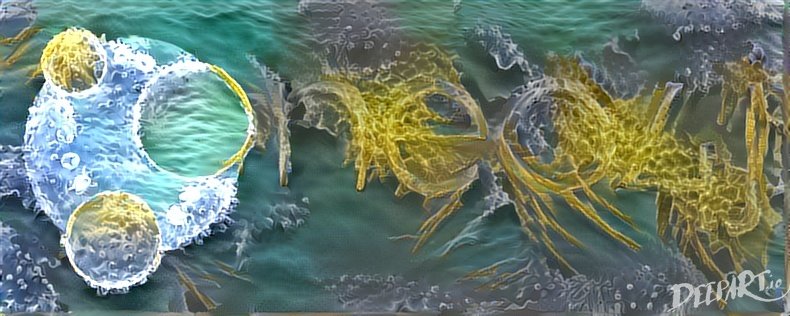
What's the best software for storing and querying hetnets?
| dhimmel/hetio | |
|---|---|
| 136 | |
| 18 | |
| 6 |



| neo4j/neo4j |
|---|
| 53,793 |
| 4,727 |
| 1,283 |
GitHub stats from 2018-02-21
- Customized Docker image
- Digital Ocean droplet
- SSL from Let's Encrypt
- readonly mode with a query execution timeout
- Custom GRASS style
- Custom guides
Public Hetionet Neo4j Instance
Details at doi.org/brsc
MATCH path =
// Specify the type of path to match
(n0:Disease)-[e1:ASSOCIATES_DaG]-(n1:Gene)-[:INTERACTS_GiG]-
(n2:Gene)-[:PARTICIPATES_GpBP]-(n3:BiologicalProcess)
WHERE
// Specify the source and target nodes
n0.name = 'multiple sclerosis' AND
n3.name = 'retina layer formation'
// Require GWAS support for the
// Disease-associates-Gene relationship
AND 'GWAS Catalog' in e1.sources
// Require the interacting gene to be
// upregulated in a relevant tissue
AND exists(
(n0)-[:LOCALIZES_DlA]-(:Anatomy)-[:UPREGULATES_AuG]-(n2))
RETURN pathHow could multiple sclerosis could affect retina layer formation?
More queries at thinklab.com/d/220
Project Rephetio contributions on Thinklab
(see thinklab.com/p/rephetio/leaderboard)
Project Rephetio: drug repurposing predictions
-
Hetionet v1.0 contains:
- 1,538 connected compounds
- 136 connected diseases
- 209,168 compound–disease pairs
- 755 treatments
- Systematic drug repurposing:
- Compare the therapeutic utility of data types
- Identify the mechanisms of drug efficacy
- Predict the probability of treatment for all 209,168 compound–disease pairs (het.io/repurpose)
Systematic integration of biomedical knowledge prioritizes drugs for repurposing
Daniel S Himmelstein, Antoine Lizee, Christine Hessler, Leo Brueggeman, Sabrina L Chen, Dexter Hadley, Ari Green, Pouya Khankhanian, Sergio E Baranzini
eLife (2017) https://doi.org/10.7554/eLife.26726


features = metapaths
observations =
compound–disease pairs
positives = treatments
negatives =
non-treatments
Machine learning methodology
Predictions succeed at prioritizing known treatments
- disease modifying treatments
+755, −208,413
AUROC = 97.4%

Predictions succeed at prioritizing experimental treatments
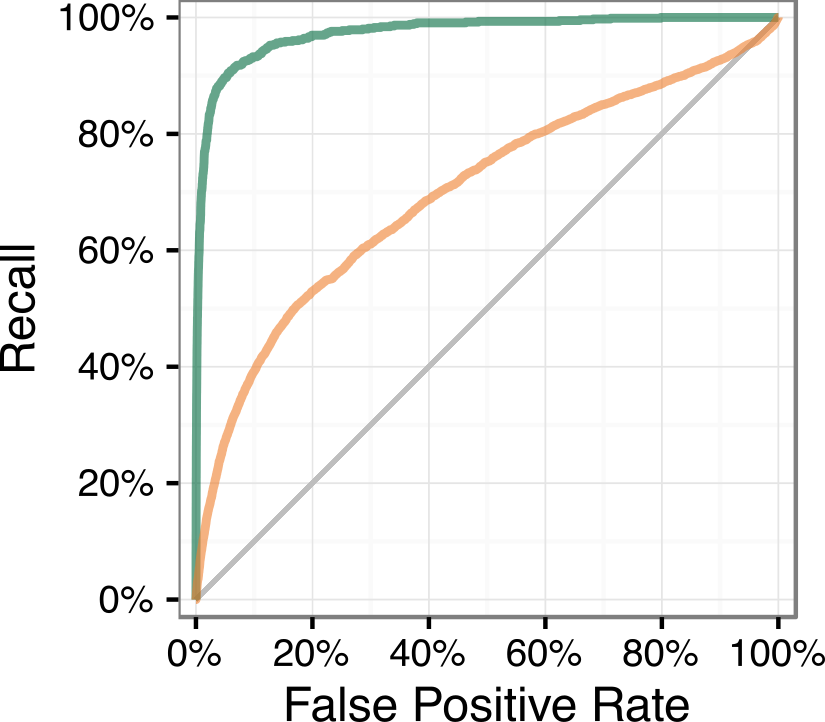
- disease modifying treatments
+755, −208,413
AUROC = 97.4%
- treatments in clinical trials
+5,594, −202,186
AUROC = 70.0%
1,206 compound–disease metapaths (length ≤ 4)
-
Upper tier:
traditional pharmacology -
Upper-middle tier:
traditionally biomedicine, but newer in drug efficacy -
Lower-middle tier:
genome-wide / high-throughput data sources -
Lower tier:
cellular components
Browse at het.io/repurpose/metapaths.html


Project Rephetio: Does bupropion treat nicotine dependence?
- Bupropion was first approved for depression in 1985
-
In 1997, bupropion was approved for smoking cessation
- Can we predict this repurposing from Hetionet? The prediction was:
- 99.5th percentile for nicotine dependence
- probability 2.50-fold greater than null

Compound–causes–SideEffect–causes–Compound–treats–Disease

Compound–binds–Gene–binds–Compound–treats–Disease

Compound–binds–Gene–associates–Disease

Compound–binds–Gene–participates–Pathway–participates–Disease
MATCH path = (n0:Compound)-[:BINDS_CbG]-(n1)-[:PARTICIPATES_GpPW]-
(n2)-[:PARTICIPATES_GpPW]-(n3)-[:ASSOCIATES_DaG]-(n4:Disease)
USING JOIN ON n2
WHERE n0.name = 'Bupropion'
AND n4.name = 'nicotine dependence'
AND n1 <> n3
WITH
[
size((n0)-[:BINDS_CbG]-()),
size(()-[:BINDS_CbG]-(n1)),
size((n1)-[:PARTICIPATES_GpPW]-()),
size(()-[:PARTICIPATES_GpPW]-(n2)),
size((n2)-[:PARTICIPATES_GpPW]-()),
size(()-[:PARTICIPATES_GpPW]-(n3)),
size((n3)-[:ASSOCIATES_DaG]-()),
size(()-[:ASSOCIATES_DaG]-(n4))
] AS degrees, path
RETURN
path,
reduce(pdp = 1.0, d in degrees| pdp * d ^ -0.4) AS path_weight
ORDER BY path_weight DESC
LIMIT 10Cypher query to find the top CbGbPWaD paths
Try at https://neo4j.het.io
Browse all predictions at het.io/repurpose. Discuss at thinklab.com/d/224
Top 100 epilepsy predictions & their chemical structure
Discuss at thinklab.com/d/224#5
Top 100 epilepsy predictions & their drug targets
Discuss at thinklab.com/d/230#14
hetmech
Kyle Kloster
@kkloste
Michael Zietz
@zietzm
https://github.com/greenelab/hetmech
the hetnet search engine for node connectivity

previously supported by

Ben Heil
@ben-heil

https://zietzm.github.io/Vagelos2017/
days to seconds
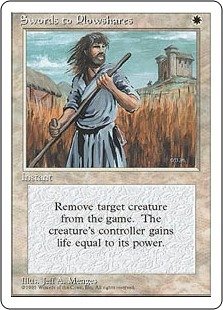
| metapath_id | path_count | dwpc | p_value | source_degree | target_degree | n_dwpcs | n_nonzero_dwpcs | nonzero_mean | nonzero_sd |
|---|---|---|---|---|---|---|---|---|---|
| DaGpBPpG | 435 | 2.8 | 0.0000% | 373 | 32 | 29,000 | 29,000 | 2.1 | 0.12 |
| DaGeAeG | 6,204 | 2.0 | 0.0000% | 373 | 28 | 53,000 | 53,000 | 1.9 | 0.02 |
| DpSpDaG | 25 | 4.4 | 0.0134% | 17 | 6 | 101,000 | 100,994 | 2.4 | 0.45 |
| DrDaG | 3 | 5.1 | 0.2442% | 5 | 6 | 181,800 | 32,414 | 3.9 | 0.51 |
| DlAlDaG | 42 | 3.7 | 0.7010% | 33 | 6 | 20,200 | 20,200 | 2.7 | 0.38 |
| DpSpDdG | 5 | 3.4 | 2.7443% | 17 | 2 | 1,065,000 | 1,009,309 | 1.9 | 0.67 |
| DrDuGiG | 1 | 1.1 | 3.2758% | 5 | 2 | 2,885,400 | 124,913 | 2.0 | 1.16 |
| DdGuDdG | 4 | 3.8 | 4.3339% | 45 | 2 | 213,000 | 142,687 | 2.9 | 0.56 |
| DdGeAeG | 739 | 1.6 | 6.1179% | 45 | 28 | 53,000 | 53,000 | 1.5 | 0.05 |
| DdGcGr>G | 1 | 2.9 | 6.8995% | 45 | 7 | 69,600 | 6,278 | 3.7 | 1.00 |
| DaG | 1 | 5.3 | 8.8886% | 373 | 6 | 20,200 | 3,591 | 5.3 | 0.00 |
| DlAdGcG | 11 | 2.0 | 9.7265% | 33 | 6 | 115,400 | 105,130 | 1.1 | 0.63 |
Most enriched types of paths connecting FTO and obesity
metapath_id path_count dwpc p_value source_degree target_degree n_dwpcs n_nonzero_dwpcs nonzero_mean nonzero_sd
DaGpBPpG 435 2.8 0.0000% 373 32 29,000 29,000 2.1 0.12
DaGeAeG 6,204 2.0 0.0000% 373 28 53,000 53,000 1.9 0.02
DpSpDaG 25 4.4 0.0134% 17 6 101,000 100,994 2.4 0.45
DrDaG 3 5.1 0.2442% 5 6 181,800 32,414 3.9 0.51
DlAlDaG 42 3.7 0.7010% 33 6 20,200 20,200 2.7 0.38
DpSpDdG 5 3.4 2.7443% 17 2 1,065,000 1,009,309 1.9 0.67
DrDuGiG 1 1.1 3.2758% 5 2 2,885,400 124,913 2.0 1.16
DdGuDdG 4 3.8 4.3339% 45 2 213,000 142,687 2.9 0.56
DdGeAeG 739 1.6 6.1179% 45 28 53,000 53,000 1.5 0.05
DdGcGr>G 1 2.9 6.8995% 45 7 69,600 6,278 3.7 1.00
DaG 1 5.3 8.8886% 373 6 20,200 3,591 5.3 0.00
DlAdGcG 11 2.0 9.7265% 33 6 115,400 105,130 1.1 0.63
Future: all biomedical knowledge in a single network
https://github.com/greenelab/snorkeling
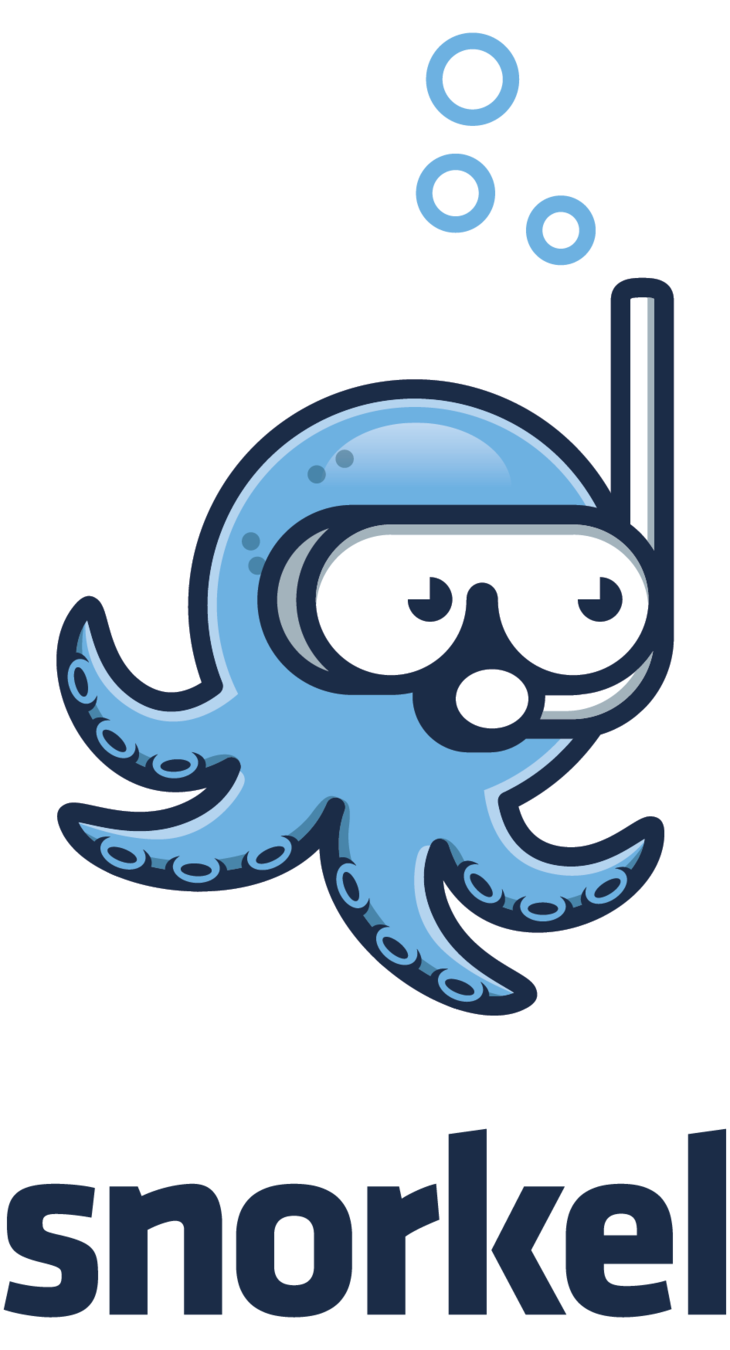
- Teach computers how to read the literature and extract knowledge.
- Continuously and automatically refine and grow the hetnet.
- Free from any legal restrictions on reuse.
David Robinson
@danich1
Questions?
@dhimmel
0000-0002-3012-7446

